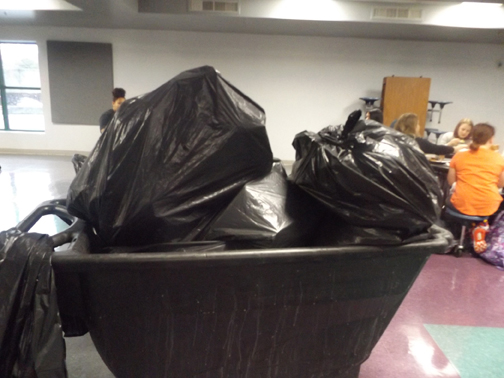COVID-19 pandemic causes food waste in school cafeterias

Katie Carmon
TAKING OUT THE TRASH. Several black trash bags full of trash and food waste are collected and removed each day. The cafeteria experiences serious food waste due to short lunch times, picky eating habits, and COVID-19.
February 15, 2022
For several years now, Sevier students have gotten free meals in the cafeteria thanks to a federal grant. Students, however, have to get the required food for each meal. Some students may not like all of the options, but they are required to get them anyway. Due to this policy, food waste is becoming a serious problem at Sevier Middle.
Some students like the food that they get, but a lot of it is thrown away because others dislike it.
Eli Gunter, a 7th grader at Sevier, eats most of what he is served.
“Some people think that the food is unappealing,” he said. “Me, well, I eat what I like.”
Sharon Price, the Nutrition Manager, finds it difficult to estimate how much food students throw away.
“The food waste is hard to judge because I do not see what students put in the trash once they leave the serving lines,” she said.
Students often throw away the food they are required to take but don’t like, even though somebody could use it if they were hungry.
Kaylynn Blair, another 7th grader, thinks that the school should save food instead of wasting it.
“I think they should make a bin for packaged food people don’t eat,” she said.
According to Price, at least the food not handed out to students is reused when possible.
“The policy that we have regarding leftover food varies,” she said. “If it is unwrapped food that has been touched by students or adults coming through the serving line, it is recorded on production records and tossed. If it is leftover food that has not been touched it will be served as a leftover the next day or frozen and served the next time it is menued. We do not have a lot of leftover food.”
Once the food is served to students, that food is tossed if it is not eaten.
“They have second options of food, so maybe they should pick the second option,” Blair said.
At school, people often think that lunch is the best part, but it all comes down to time. Students usually get 20 minutes to eat at Sevier. Some feel that’s not enough time.
Gunter believes that more time to eat could cut down on food waste.
“Yes, because we have had only 20 minutes to eat,” he said. “Students need to eat food or they will be hungry in the afternoon.”
Blair disagreed.
“I have plenty of time, but some students have more time than me, so maybe they should add more time to eat,” she said.
Price feels that time is not the problem.
“I do think students have enough time to eat lunch,” she said. “On average, we have students through the lunch line between 4- 6 minutes. We see a lot of students hurry to eat their lunch and then spend their remaining time running around the cafeteria.”
It is the student’s picky eating habits, according to Price, that lead to waste.
“I believe the waste that we have is due to the fact that students only want, for example, an entree like cheese sticks,” she said. “In order to get that at no cost, the student must pick up a fruit or vegetable to meet the federal mandated food requirements.”
These federal food requirements state that students must pick up 3 different components in order to receive the meal at no cost, such as an entrée, a fruit and a vegetable. They can get up to 5 items.
Once a student has gone through the cashier and out into the cafeteria they cannot exchange or return an item. The exception to that would be if there was something wrong with the item. It can be returned and exchanged.
“The reason we need the item returned is because everything has to be accounted for and documented on my paperwork,” Price said. “This is a federal and state requirement.”
Before COVID-19, the cafeteria made efforts to save unopened, pre-packed food and milk. Due to COVID-19, these efforts have all but stopped.
“I believe COVID’s biggest impact on the cafeteria pertaining to food waste is being unable to have ‘share tables’,” Price said.
This has not been the only impact of COVID on the cafeteria.
“COVID has put a lot of burdens on not only our cafeteria but all the cafeterias nationwide,” Price said. “We are having to do a limited menu in part to not being fully staffed and we never know if we will get the food and paper products that I have ordered.”
In the end, Price is certain there is a way, even during a pandemic, to cut down on food waste.
“The best way to fight food waste is to not pick up items that will not be consumed,” she said.
This story was originally published on The Sequoyah Scribe on December 8, 2021.



































